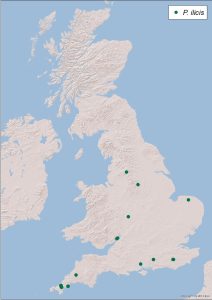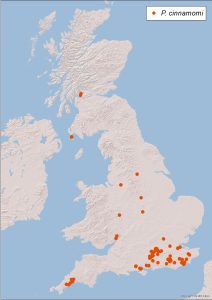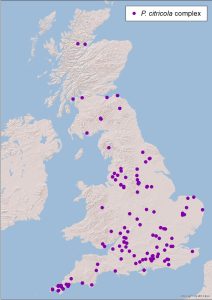Summary
Phytophthoras are a group of microscopic fungal pathogens responsible for major plant diseases in many parts of the world, although prior to the 1990s they had relatively little impact in European woodlands. However, over the past two decades this has changed markedly, and our aim is to improve understanding of the distribution of Phytophthora species in Britain and the trees they affect.
Research objectives
This project aims to analyse past and current records generated from various Forest Research projects and the Tree Health Diagnostic & Advisory Service to plot the distribution of the most damaging and best known species in Britain.
Specific objectives are to:
- Build spatial maps showing the distribution of a range of Phytophthora species.
- Show the host range of each mapped Phytophthora species, indicating the most common and least common tree hosts.
- Use the records, behavioral traits of each Phytophthora, and climatic data to predict how distribution may change in the future.
Results so far
Over 3,000 Forest Research records for Phytophthoras which date from 1975 to the present day have been analysed as a precursor to mapping. First draft distribution maps have now been generated for ten Phytophthora species frequently encountered in Britain. These are:
- Phytophthora alni
- Phytophthora austrocedri
- Phytophthora cactorum
- Phytophthora cambivora
- Phytophthora cinnamomi
- Phytophthora citricola (species complex)
- Phytophthora gonapodyides
- Phytophthora ilicis
- Phytophthora kernoviae
- Phytophthora pseudosyringae
- Phytophthora syringae
More recently, other less well known Phytophthora species including P. siskiyouensis, P. foliorum and P. gallica have also been found in Britain and research is underway to learn more about their behaviour and potential hosts.
Status
This project started the 1st April 2015 and is ongoing
Contact
Funders and partners
This project is funded jointly through Horizon 2020 and the Forestry Commission as part of the research programme Understanding Threats to Resilience
The research is in line with support to government policies of sustainable forest management as laid out in The UK Forestry Standard and its supporting series of Guidelines.
Phytophthora cinnamomi
This species, although an introduction, has probably been in Britain for well over 100 years. Although P. cinnamomi is often found on ornamentals including shrubs, increasingly it has been found to affect trees such as sweet chestnut, oak, and yew, attacking the roots and root collar. The disease it causes on sweet chestnut is known as ink disease because of the blackish colour of infected roots and associated soil. Reports of ink disease affecting sweet chestnut in the New Forest were first published in the 1930s and the incidence of the disease is probably increasing due to the milder winters and warmer summers which are likely to allow P. cinnamomi to become more widespread.
Phytophthora cinnamomi is favoured in continental climates, so is most frequently found in south east England. It is considered sensitive to frost, but despite this there are records of this species as far north as Scotland.
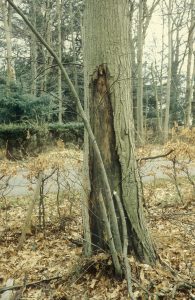
Tree genera affected by P. cinnamomi
| Occurrence | Host |
| Frequent | Castanea |
| Occasional | Chamaecyparis, Quercus, Taxus |
| Uncommon | Cedrus, Fagus, Larix, Pseudotsuga |
Distribution map (2022)
Phytophthora citricola complex
This species of Phytophthora is widespread and based on dated records has been present in Britain for more than 80 years. In the early 2000s P. citricola was found to be a complex of several morphologically similar species which have since been given different names. The main species within the P. citricola complex which is most commonly found in Britain is now called P. plurivora. Most of the historic records of P. citricola are therefore likely to be P. plurivora.
Like P. cinnamomi, P. plurivora is a root attacking Phytophthora. In culture at least it tends to grow best at a temperature of 25c and therefore is found most frequently in southern Britain but is also widely distributed throughout Britain as the map indicates. It has been found infecting a wide range of mainly broadleaf tree species – beech and sycamore are very common hosts. Typical symptoms include bleeding lesions on the lower trunk and root collar area.
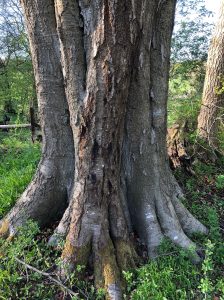
Tree genera affected by P. citricola complex
| Occurrence | Host |
| Frequent | Acer, Fagus, Tilia |
| Occasional | Nothofagus, Aesculus |
| Uncommon | Abies, Alnus, Chamaecyparis, Picea, Quercus |
Distribution map (2022)
Phytophthora pseudosyringae
This species was named as one of the newly defined species within the P. citricola complex in 2003, but has probably been present in Britain for decades and may even be a native. It has a much lower temperature optimum for growth compared with its ‘sister’ species P. plurivora.
Also like P. plurivora it often attacks the roots and root collar of beech, but it can also infect the aerial parts of trees. Phytophthora pseudosyringae has proved to be a very damaging pathogen to Nothofagus trees, particularly Nothofagus obliqua, causing trunk and branch lesions on this tree species and sporulating abundantly on the leaves. Its distribution in Britain is similar that of P. ramorum and it is found throughout much of western Britain.
Tree genera affected by P. pseudosyringae
| Occurrence | Host |
| Frequent | Nothofagus, Fagus |
| Occasional | Larix |
| Uncommon | Carpinus, Ilex, Tilia |
Distribution map (2017)
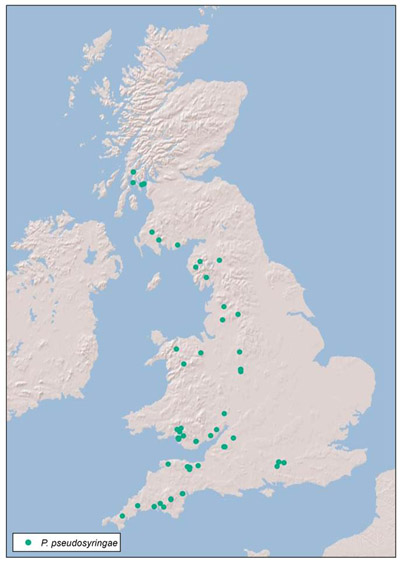
Phytophthora ilicis
This species causes a disease known as holly blight that can affect several holly species. The disease is specific to holly, although depending on species some may be more susceptible than others. This is another example of an introduced Phytophthora pathogen, the native range of P. ilicis is thought to be North America and it was first detected in Britain in the 1980s.
Symptoms of holly blight include premature leaf shedding and twig dieback Damage is most obvious in winter when leaves develop blackened lesions as P. ilicis invades the tissue. Another tell-tale sign can be many prematurely fallen leaves on the ground under affected holly trees. With more susceptible holly species, not only the leaves are infected but the pathogen extends into shoots and twigs causing cankers and dieback. Outbreaks of the disease tend to follow a period of wet, cool weather which is ideal for infection.
Since being found in Britain more than 40 years ago, P. ilicis is now widespread and can be found throughout much of the UK and Ireland, although affected holly trees are mostly seen in England.
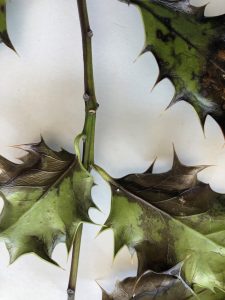
Tree genera affected by P. ilicis
| Occurrence | Host |
| Frequent | Ilex (mainly Ilex aquifolium but also infects non-native holly species) |
Distribution map (2022)
